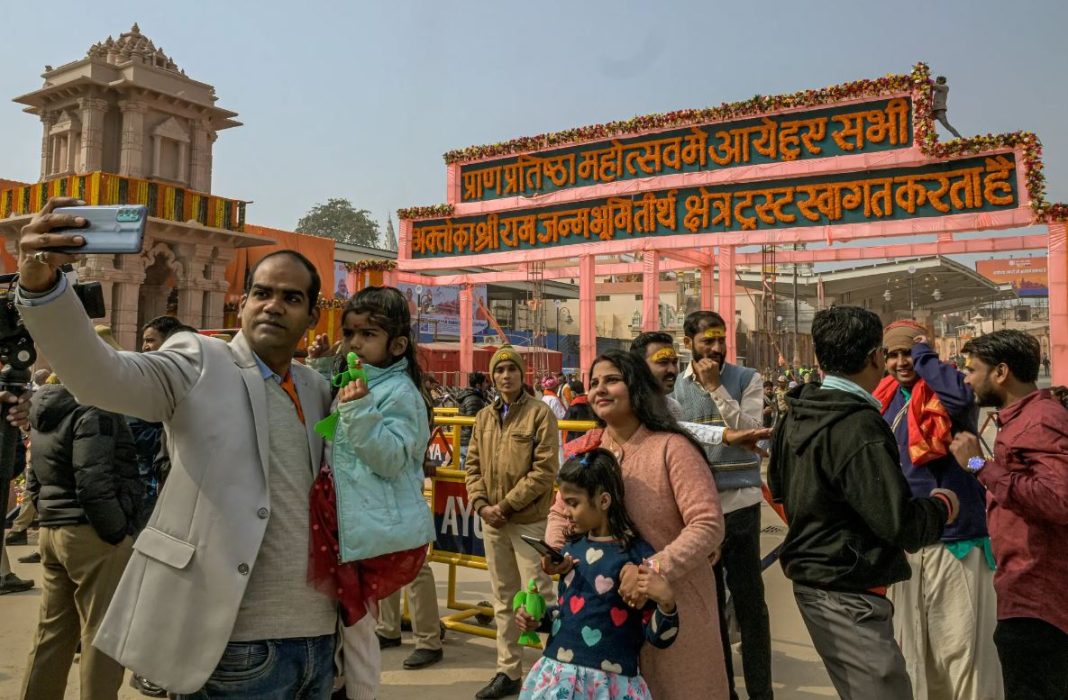Prime Minister Narendra Modi is set to inaugurate a colossal new temple in the Indian city of Ayodhya, marking the culmination of a mostly 20th-century journey during which Hindu nationalists dismantled a centuries-old mosque. The mosque has now been replaced with a structure dedicated to the Hindu deity Ram.
Leading up to the temple’s consecration, public spaces throughout India were buzzing with excitement. Ram holds a revered status among India’s Hindus, constituting about 80 percent of the total population of 1.4 billion. As the central figure of the Ramayana epic, Ram is a king and a symbol of virtue who, after exile from his native Ayodhya, returns for a triumphant coronation.
Islam is absent from the Ramayana, having arrived in India only 1,000 years ago. However, in the Hindu-nationalist narrative of India’s history, Islam is depicted as the primary antagonist. With the inauguration of the temple and a spiritual and political homecoming for Prime Minister Modi, the Ram campaigners have achieved the temple they sought for decades.
What Sets This Temple Apart?
Firstly, there is a theological reason. Ayodhya is considered Ram’s original home, where his just rule commenced on the banks of the Sarayu River. Diwali, India’s major festival, marks the end of his 14-year exile from the place.
Then, there is a more historical explanation. In the vicinity of Ayodhya, it was long believed that a Hindu temple had once stood on the land where the Babri Mosque was constructed in the 1500s. In 1949, after British rule ended and India gained independence, Hindu activists secretly placed idols representing Ram inside the mosque, escalating the dispute over the site. This event led to ongoing conflicts between Hindus and Muslims over access to the site.
During the 1980s, reclaiming the site became a primary goal of the Hindutva movement, which aimed to associate multiethnic India with Hinduism. As a new political leader, Modi participated in the Ram temple campaigns, marked by clashes with the police and Hindu-Muslim riots. The tensions culminated in 1992 when about 2,000 people were killed in sectarian violence.
What Happened in 1992?
On December 6, 1992, the Bharatiya Janata Party (B.J.P.), representing Hindutva, organized nearly 100,000 volunteers to gather in Ayodhya. The party ran the local government, and when a mob eventually stormed the mosque, the police stood idly by. By the end of the day, the mosque’s domes were flattened, and a makeshift temple was erected.
The demolition and the subsequent violence horrified many in India’s cities. The B.J.P., which was a marginal player until then, gained strength following these events, combining pro-Hindu causes with a pro-business orientation during a period of economic liberalization. Legal disputes over the disputed land persisted until 2019 when the Supreme Court cleared the way for the construction of the Ram temple.
What’s Happened Since Then?
After the mosque’s demolition, the disputed land was entangled in legal decisions until soon after Modi won his second term as prime minister in 2019. The Supreme Court ruled that the mosque’s destruction was illegal but allowed the claim to be handed over to a Ram Temple Trust.
Construction began in 2020, with the trust raising about $400 million privately. The consecration of the Ram temple has become a project of the Indian state, with about 70 percent of the temple already built. Ayodhya has witnessed significant infrastructure development, including a new airport, train services, and urban upgrades.
The inauguration of the Ram temple was marked as a national half-day holiday, allowing Indians everywhere to celebrate the installation of the official Ram idol in the new premises.
How Do Indians View the Temple?
Hindu nationalist supporters of Modi see the temple inauguration as a day of ultimate vindication or even revenge against India’s medieval Muslim rulers and the country’s independence leaders. Secularists view the rise of the Ram temple as confirmation of their defeat and a problematic conflation of Modi with Ram. India’s 200 million Muslim citizens generally feel alienated.
However, many Hindus, particularly in the northern part of the country, perceive it as a positive development that Ram will finally have a temple at his holy birthplace. Younger Indians, unfamiliar with the events of 1992, observed the day’s spectacle without recalling the Babri Mosque. The timing of the inauguration seems calculated to boost Modi’s campaign for a third term in the upcoming elections.
The construction of the Ram temple signifies the intersection of religion and politics, impacting India’s social and political landscape and generating diverse reactions among its citizens.

